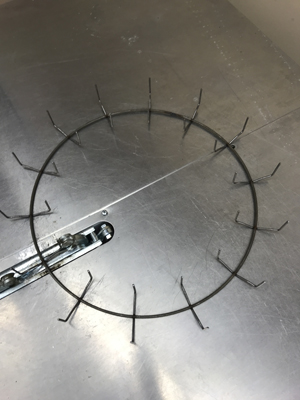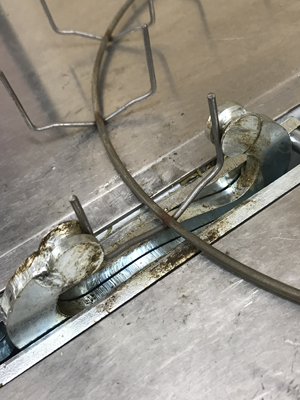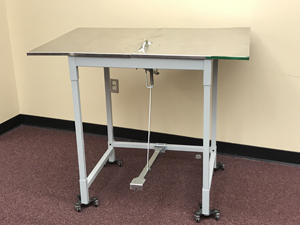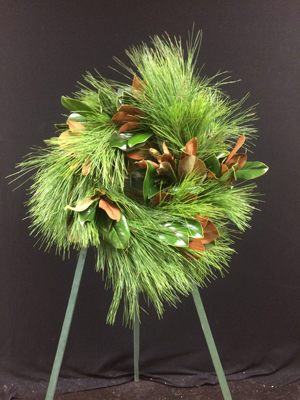Pine and Magnolia Wreath (Pinus elliottii and Magnolia grandiflora) for the Farmer Florist
Production
Slash Pine (Pinus elliottii)
Slash pine has a broad range but is best grown in sandy, subtropical forests. Slash pine grows best in warm, moist areas, as it does not tolerate extreme cold and is especially sensitive to ice damage. It can grow across a large range of soil types but prefers sites with high soil moisture, typically near bodies of water. It grows at a relatively fast rate, attaining about 14 to 24 inches of growth per year. This is a large-growing tree that reaches heights of 75 to 100 feet at biological maturity.
In the landscape, slash pine trees are generally planted in spring, when seedlings are easily found at greenhouses
and nurseries. Reforestation occurs in the winter with the planting of bare-root or containerized seedlings. Growing a slash pine tree isn’t difficult, as this is a hardy species. Avoid high pH levels and make sure it gets plenty of sun (about 4 hours per day) for successful growth.
Fertilize newly planted trees using a slow-release, general-purpose fertilizer that won’t burn the sensitive roots. A regular, balanced fertilizer with a nitrogen-phosphorus-potassium (N-P-K) ratio of 10-10-10 is fine once the tree is a few years old. Slash pine trees also benefit from a layer of mulch around the base, which keeps weeds in check and helps keep the soil evenly moist. Mulch should be replaced as it deteriorates or blows away.
Its needles may be 5 to 11 inches long. Cones are a glossy reddish-brown and 3 to 6 inches long. Its thin cone scales are useful as decorations as they have a glossy, brown coloring unlike the other most common softwood pines in the Southeast. Be warned that slash pine is the most susceptible pine tree to fusiform rust, a fungus that can prove fatal to the tree.
Southern Magnolia (Magnolia grandiflora)
With a native range encompassing the southeastern United States from Maryland to Florida and east to Texas, southern magnolias are a core element in many Southern landscapes. Southern magnolias can be grown in a variety of environmental conditions, although they prefer acidic and moist but well-drained soils. Numerous cultivars of southern magnolia are available today, including large and small tree and leaf types. Southern magnolias are known for their beautiful, creamy-white flowers during spring and summer.
In addition to the showy, gently fragrant flowers, the evergreen foliage of southern magnolias provides texture and contrast to the landscape. The leaves are large and glossy with dark green upper surfaces and often brown fuzz on the undersides. These characteristics make southern magnolia an excellent choice for wreath-making. Farmer florists can take advantage of southern magnolias by offering both cut material and finished wreaths to customers.
While materials can be sourced from established native stands or landscapes, you can easily establish and maintain southern magnolias on the farm to maximize plant growth and profit. Southern magnolias can be incorporated into the farm landscape as single specimen plants, as hedges separating various sections of the farm or along property boundaries, or even as espaliers (plants whose branches are trained to grow against a flat structure).
Larger southern magnolias such as ‘D.D. Blanchard’, ‘Bracken’s Brown Beauty’, and ‘Claudia Wannamaker’ make excellent specimen trees in the landscape, growing to 50 feet or higher. Smaller southern magnolias such as ‘Little Gem’, ‘Teddy Bear’, or narrow-growing ‘Alta’ can
be used as small specimen trees or grown in a line as a hedge. Any southern magnolia can be grown as an espalier, but this method requires more skill and labor. Consider planting several different cultivars of southern magnolia because leaf shapes and amounts of leaf fuzz vary and can influence the character of the finished products.
Containerized southern magnolias can be established on the farm during any time of year. Balled-and-burlapped southern magnolias are usually transplanted from late summer to early fall. Dig the planting hole 1½ to 2 times the diameter of the root ball and equal to or slightly less than the height of the root ball. Once planted, the basal flare of the trunk should be visible above the soil line.
Backfill the planting hole with native soil, making sure to break up any clumps. Irrigate after transplanting and as needed throughout the year. Do not fertilize at transplanting; base fertilization on soil-test recommendations after plants are established.
Harvest and Handling
Harvest magnolia and pine stems from 8 to 24 inches long. Look for branches with plenty of leaves. Harvest magnolia stems for floral designs after new growth has matured in the spring (this is not a problem for this style of wreath that has consumer appeal in December). It is best to keep cut magnolia and pine branches cool and moist once they are harvested. If there is a large gap in time (days) between harvest and design construction, keep stems in fresh flower food solution in waxed boxes or wrapped in vinyl sheets/ bags, and store them in a cool area. If you use sheets/bags, be sure to vent stored bundles by poking holes into the plastic. Moist, still air harbors gray mold (Botrytis cinerea) as well as other pathogens that can lower magnolia’s quality in storage. Store pine and magnolia in water and refrigerate for up to 6 weeks.
Design Construction
Prune stems to approximately 8-inch lengths. You need about 3 pounds of pine and magnolia stems to produce one wreath. The wreath here was made on a 14-inch-diameter frame. The finished design has a 24-inch outside diameter and takes about 30 minutes to construct using a clamping-type wreath machine.
The wreath frame has wire prongs that hold loose bunches of plant material. The machine uses force to clamp the prongs around a cluster of about four to six stems, holding them tightly in place. The clamping action is operated by a foot pedal, leaving your hands free to hold materials in place. Having the clamp mechanism permanently attached to a table is a best practice for commercial producers and a good choice for producers entering the wreath-making marketplace.




Purchasing the materials to make this design from a wholesale florist would cost around $45. Our study found consumers are willing to pay significantly less than that figure, on average about $27. This cost difference should not be the deciding factor in producing these products, however. You can grow your own plant materials and then add value through design.
Note: The Southern Christmas Tree Association (Alabama, Louisiana, Mississippi) assists growers in the production and marketing of high-quality, real Christmas trees for consumers.
References
Posadas, B. C., and J. Del Prince. 2019. Consumer preferences and willingness to pay for wreath designs. Mississippi Agricultural and Forestry Experiment Station Bulletin, Mississippi State, Mississippi.
The information given here is for educational purposes only. References to commercial products, trade names, or suppliers are made with the understanding that no endorsement is implied and that no discrimination against other products or suppliers is intended.
Publication 3499 (POD-09-23)
By James DelPrince, PhD, Assistant Extension Professor, Coastal Research and Extension Center; Ben Posadas, PhD, Associate Extension/Research Professor, Coastal R&E; Patricia Knight, PhD, Research Professor and Director of Coastal Horticultural Research, South Mississippi Branch Experiment Station; Shaun Tanger, PhD, Assistant Professor, Coastal R&E; and Christine Coker, PhD, Associate Extension/Research Professor, Coastal R&E.
The Mississippi State University Extension Service is working to ensure all web content is accessible to all users. If you need assistance accessing any of our content, please email the webteam or call 662-325-2262.


